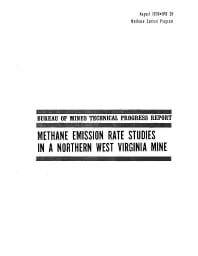Mining Publication: Methane Emission Rate Studies in a Northern West Virginia Mine
Original creation date: August 1970
Authors: S Krickovic, C Findlay, WM Merritts
NIOSHTIC2 Number: 10009735
U.S. Department of the Interior, Bureau of Mines. Technical Progress Report 28, 1969; NTIS No. PB-194949 :1-11
Methane emission rates were studied in a Pittsburgh coalbed mine in northern West Virginia. A fullface boring-type continuous miner, equipped with a methane monitor, was used in the development of a set of eight main headings, one side of which was near old workings; the other side abutted virgin coal. Two air splits ventilated the section. Air volumes and methane percentages were recorded, and time studies of the miner were made during five consecutive operating days, during which a complete cycle of mining the headings and one line of related breakthroughs was accomplished. Methane emission rates increased significantly as mining progressed from the side near old mine workings toward the virgin area, and generally increased with coal extraction. Mining in the heading immediately adjacent to virgin coal was interrupted quite frequently, owing to excessive methane concentrations at the face, despite adequate air volumes and acceptable methane concentrations in the immediate return airway.

NIOSHTIC2 Number: 10009735
U.S. Department of the Interior, Bureau of Mines. Technical Progress Report 28, 1969; NTIS No. PB-194949 :1-11
- Composition Change Model for Sealed Atmosphere in Coal Mines
- Methane Control by Isolation of a Major Coal Panel - Pittsburgh Coalbed
- Methane Emission from U.S. Coal Mines in 1975, A Survey : A Supplement to Information Circulars 8558 and 8659
- Methane Emission from U.S. Coal Mines, A Survey
- Methane Emission Rate Studies in a Central Pennsylvania Mine
- Methane Emissions from an Advancing Coal Mine Section in the Pittsburgh Coalbed
- Methane Migration Characteristics of the Pocahontas No. 3 Coalbed
- Remote Methane Sensors
- Removing Methane (Degasification) from the Pittsburgh Coalbed in Northern West Virginia
- Reservoir Rock Properties of Coal Measure Strata of the Lower Monongahela Group, Greene County (Southwestern Pennsylvania), from Methane Control and Production Perspectives